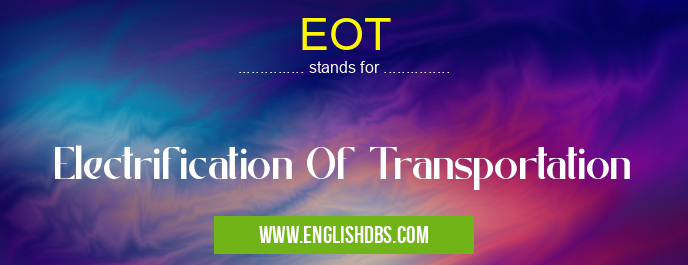What does EOT mean in TRANSPORTATION
Electrification Of Transportation (EOT) refers to the progressive shift towards using electricity as the primary power source for transportation systems, including vehicles, trains, and other modes of transport. This transition aims to reduce reliance on fossil fuels, enhance energy efficiency, and mitigate environmental impact.

EOT meaning in Transportation in Governmental
EOT mostly used in an acronym Transportation in Category Governmental that means Electrification Of Transportation
Shorthand: EOT,
Full Form: Electrification Of Transportation
For more information of "Electrification Of Transportation", see the section below.
EOT Meaning in GOVERNMENTAL
In the context of government policies and regulations, EOT often pertains to initiatives aimed at promoting the adoption and infrastructure development for electric vehicles (EVs) and other electrified transportation technologies. Governments may establish targets, provide incentives, and implement policies to encourage the transition to EOT.
EOT Full Form
- Electrification Of Transportation
What does EOT Stand for?
- Electrification
- Of
- Transportation
Essential Questions and Answers on Electrification Of Transportation in "GOVERNMENTAL»TRANSPORTATION"
What is Electrification of Transportation (EOT)?
Electrification of transportation refers to the process of shifting from gasoline-powered vehicles to electric vehicles (EVs) to reduce carbon emissions and improve air quality.
What are the benefits of EOT?
EOT offers several benefits, including:
- Reduced air pollution and greenhouse gas emissions
- Lower operating costs compared to gasoline vehicles
- Increased energy efficiency and reduced dependence on fossil fuels
- Enhanced driving performance and responsiveness
What are the different types of electric vehicles?
There are various types of electric vehicles:
- Battery Electric Vehicles (BEVs): Powered solely by electricity stored in batteries
- Plug-in Hybrid Electric Vehicles (PHEVs): Combine a gasoline engine with an electric motor and battery, allowing for both electric and gasoline operation
- Hybrid Electric Vehicles (HEVs): Utilize a gasoline engine and an electric motor that assists during acceleration and braking, but cannot operate solely on electricity
How does the charging infrastructure for EVs work?
EV charging infrastructure includes a network of charging stations where EV owners can connect their vehicles to charge batteries. These stations vary in power output and charging speed, and can be found at various locations, such as public parking garages, shopping malls, and dedicated charging stations.
What are the challenges associated with EOT?
While EOT offers significant benefits, there are challenges to consider:
- Battery range limitations and charging time concerns
- Initial higher purchase price of EVs compared to gasoline vehicles
- Limited availability of charging stations, especially in rural areas
- Grid infrastructure upgrades may be necessary to support increased EV adoption
Final Words: EOT plays a crucial role in advancing sustainable and environmentally friendly transportation practices. By reducing fossil fuel consumption and promoting energy efficiency, EOT contributes to the mitigation of greenhouse gas emissions and the improvement of air quality.
EOT also stands for: |
|
| All stands for EOT |
